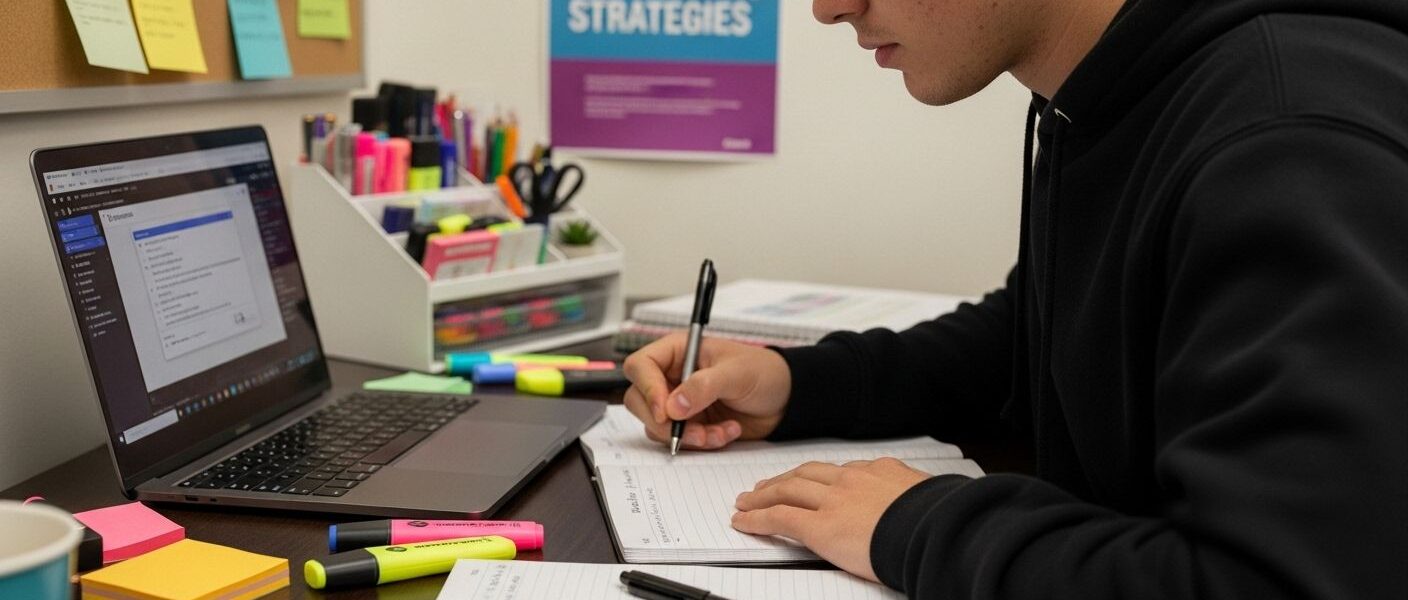
Finding the right note taking method can completely shift how you remember and understand new information. Studies show that matching your note taking style to your learning preferences can dramatically boost retention and comprehension. Most people grab a notebook or open a new app and just start writing, thinking any method will do. The twist is that your ideal system might look totally different from your classmate’s and the real secret starts with understanding yourself first.
Table of Contents
- Step 1: Identify Your Note Taking Needs
- Step 2: Choose Your Note Taking Tools
- Step 3: Develop A Consistent Format
- Step 4: Practice Active Listening Or Reading
- Step 5: Review And Revise Your Notes
- Step 6: Test Your Understanding
Quick Summary
| Key Point | Explanation |
|---|---|
| 1. Assess Your Learning Style | Identify if you are a visual or auditory learner to tailor your note taking effectively. |
| 2. Choose the Right Tools | Select digital or analog tools that match your personal learning preferences for better retention. |
| 3. Develop a Consistent Format | Establish a standardized note taking structure to enhance comprehension and ease of review. |
| 4. Practice Active Listening | Engage actively during lectures by positioning yourself well and asking questions to deepen understanding. |
| 5. Regularly Review and Revise | Revise your notes within 24 hours to fill gaps and solidify your understanding of the material. |
Step 1: Identify Your Note Taking Needs
Successful note taking begins with a critical self-assessment of your unique learning style and academic requirements. Understanding how you absorb and process information is the foundation of developing effective note taking strategies that will transform your learning experience.
Your personal learning profile involves several key dimensions that directly impact how you capture and retain information. Visual learners typically benefit from graphical representations, color coding, and spatial organization of notes. These individuals remember information best when they can see diagrams, charts, and visual connections between concepts. Auditory learners, by contrast, excel when notes involve listening, verbal repetition, and spoken summaries of key points.
To identify your specific note taking needs, start by reflecting on past learning experiences. Consider the subjects where you’ve felt most engaged and successful. Were those classes characterized by interactive discussions, visual presentations, hands-on experiments, or detailed lectures? Your previous academic performance provides valuable insights into your optimal learning approach.
According to Portland State University, matching your note taking method to your individual learning style can dramatically improve information retention and comprehension. This means experimenting with different techniques to discover what resonates most with your cognitive processing.
Practical assessment techniques include:
- Trying multiple note taking formats like mind mapping, Cornell method, and outline structures
- Recording your retention rates after using different note taking approaches
- Seeking feedback from instructors or study partners about the clarity of your notes
Remember that your note taking strategy is not permanently fixed. As you progress through different academic stages and encounter varied learning environments, your approach will naturally evolve. Remain flexible and open to refining your techniques, always prioritizing methods that help you understand and remember information most effectively.
Successful note taking is about creating a personalized system that transforms complex information into clear, accessible knowledge. By taking the time to understand your unique learning profile, you’re laying the groundwork for academic success and lifelong learning.
For a quick overview of the main steps in mastering effective note taking, refer to this table summarizing each stage and its intended outcome.
| Step | Focus Area | Key Outcome |
|---|---|---|
| 1. Identify Note Taking Needs | Assess learning style and requirements | Find optimal note taking approach |
| 2. Choose Tools | Select digital, analog, or hybrid solutions | Use tools that fit learning preferences |
| 3. Develop Consistent Format | Structure notes for clarity and review | Enhance comprehension and efficient review |
| 4. Practice Active Listening | Engage with lectures and readings | Deepen understanding during content intake |
| 5. Review and Revise | Revisit and improve notes | Fill gaps and solidify understanding |
| 6. Test Understanding | Self-assess using various strategies | Strengthen retention and identify weaknesses |
Step 2: Choose Your Note Taking Tools
Selecting the right note taking tools is a crucial step in developing an effective learning strategy. Your chosen tools should seamlessly integrate with your learning style, academic requirements, and personal preferences while providing flexibility and efficiency.
Digital tools have revolutionized note taking, offering unprecedented versatility and accessibility. Modern students can choose from a wide range of applications that support multiple formats including text, audio, images, and interactive diagrams. Platforms like Evernote, OneNote, and Notion provide cloud synchronization, allowing you to access your notes across multiple devices and ensure your study materials are always within reach.
Physical note taking tools remain equally valuable for many learners. Analog tools such as high-quality notebooks, specialized graph paper, colored pens, and mechanical pencils can provide a tactile learning experience that enhances memory retention. Some students find that the physical act of writing helps them process and remember information more effectively than digital typing.
According to University of Arkansas for Medical Sciences, the most effective note taking approach involves selecting tools that match your personal learning style and the specific requirements of your courses. Consider factors like portability, ease of organization, search capabilities, and your comfort level with technology when making your selection.
Practical considerations for tool selection include:
- Compatibility with your primary learning devices
- Storage and backup capabilities
- Ease of searching and retrieving information
- Cost and accessibility
Hybrid approaches can also be powerful. Many students combine digital and physical tools, using tablets with stylus pens, scanning handwritten notes into digital platforms, or using digital tools to supplement traditional notebooks. Learn more about smart study techniques to enhance your note taking strategy.
Ultimately, the best note taking tools are those that you will consistently use and that support your natural learning process. Experiment with different options, remain open to adaptation, and prioritize tools that make capturing and reviewing information both easy and enjoyable.
To help you compare popular note taking tools and their key features, use the table below as a reference for selecting the option that best fits your learning style.
| Tool Type | Example Tools | Key Features | Best For |
|---|---|---|---|
| Digital | Evernote, OneNote, Notion | Cloud sync, multimedia support, searchability | Visual and auditory learners |
| Physical/Analog | Notebooks, graph paper | Tactile writing, customization, no device needed | Kinesthetic, visual learners |
| Hybrid | Tablets with stylus, scanned notes | Combines handwriting with digital storage | Learners who value flexibility |
Step 3: Develop a Consistent Format
A consistent note taking format is the backbone of effective learning and information retention. By establishing a structured approach to capturing and organizing information, you transform random notes into a powerful learning tool that enhances comprehension and recall.
Standardizing your note taking format provides multiple cognitive benefits. When you develop a predictable structure, your brain can more easily process and store information. This consistency reduces mental effort during note taking, allowing you to focus more on understanding the content rather than figuring out how to record it.
The Cornell Method offers an excellent framework for creating a systematic approach. This method involves dividing your page into specific sections: a narrow left column for cues and questions, a wider right column for detailed notes, and a bottom section for summarizing key takeaways. By implementing this or a similar structured approach, you create a repeatable system that makes reviewing and studying significantly more efficient.
According to Bowdoin College’s Baldwin Center for Learning and Teaching, developing a consistent format involves more than just creating a template. It requires intentional practice and adaptation to different subject matters and learning environments.
Key elements of a robust note taking format include:
- Clear headings and subheadings
- Consistent abbreviation systems
- Systematic use of highlighting or color coding
- Dedicated spaces for personal reflections or questions
Flexibility within structure is crucial. While maintaining a consistent overall format, allow room for slight modifications based on the specific subject or lecture style. Some courses might require more diagrams, while others demand more text-heavy notes. Your format should be adaptable yet recognizable.
Practice is essential in making your chosen format feel natural. Spend time experimenting and refining your approach. Review your notes periodically, looking for ways to improve clarity, reduce unnecessary information, and enhance your personal learning process.

Remember that your note taking format is a personal tool. What works perfectly for one student might feel awkward for another. The goal is to create a system that feels intuitive and supports your unique way of understanding and remembering information.
Step 4: Practice Active Listening or Reading
Active listening and reading transform passive information consumption into an engaging, dynamic learning experience. This critical skill goes beyond simply hearing words or scanning text, requiring full mental engagement and strategic interaction with the material being presented.
Intentional focus is the cornerstone of active learning. When attending lectures or reading academic materials, your goal is to become an active participant rather than a passive recipient. This means preparing mentally before the session, maintaining physical and cognitive alertness, and developing a proactive approach to capturing information.
For lecture environments, positioning yourself strategically can dramatically improve your ability to listen effectively. Choose a seat where visual and auditory distractions are minimized, allowing you to concentrate fully on the instructor’s content. Physical positioning plays a significant role in your ability to absorb information, so sit where you can maintain clear eye contact and hear every word clearly.
According to Princeton University’s McGraw Center for Teaching and Learning, effective active listening involves several key strategies. Before the lecture or reading session, review previous related materials to establish context. During the presentation, train yourself to identify main ideas, supporting details, and potential connections to previously learned concepts.
Critical active listening techniques include:
- Anticipating the speaker’s next points
- Asking mental questions about the material
- Connecting new information with existing knowledge
- Watching for verbal and non-verbal cues indicating importance
For reading materials, active engagement means interacting with the text through techniques like underlining key passages, writing marginal notes, and summarizing paragraphs in your own words. This approach transforms reading from a passive scanning activity into an interactive learning process that enhances comprehension and retention.
Remember that active listening and reading are skills that improve with deliberate practice. Start by implementing these strategies gradually, being patient with yourself as you develop this critical learning capability. Your ability to absorb, process, and retain information will continue to grow as you refine these techniques.
Step 5: Review and Revise Your Notes
Reviewing and revising your notes is the critical bridge between capturing information and truly understanding it. This transformative step turns raw notes into a powerful learning tool that enhances long-term retention and comprehension.
Timing is everything when it comes to note review. Ideally, you should revisit your notes within 24 hours of the original lecture or reading session. This window represents the optimal moment when information is still fresh in your memory, allowing you to fill in gaps, clarify confusing points, and strengthen your understanding.
The review process is more than simply reading through your notes. Active revision involves critically engaging with the material, creating connections between new information and existing knowledge. As you review, ask yourself probing questions: What are the key concepts? How do these ideas relate to previous learning? What questions remain unanswered?
According to Edutopia, effective note revision includes creating original summaries and developing questions about the material. This approach transforms passive note-taking into an active learning experience that deepens your understanding and improves information retention.
Strategic revision techniques include:
- Color-coding key concepts and relationships
- Adding explanatory margin notes
- Creating summary statements at the end of each section
- Identifying areas that require additional research or clarification
Digital tools can significantly enhance your note revision process. Many note-taking applications offer features like highlighting, tagging, and cross-referencing that make revision more interactive and comprehensive. Consider using cloud-based platforms that allow you to easily update and organize your notes across multiple devices.
Consistent revision is a skill that develops over time. Start by dedicating 15-30 minutes after each study session to review and refine your notes. As you become more practiced, you’ll develop an intuitive approach to capturing and reinforcing important information. The goal is to transform your notes from a passive record into an active learning resource that supports your ongoing academic growth.
Step 6: Test Your Understanding
Testing your understanding transforms passive note taking into an active learning process that solidifies knowledge and reveals potential gaps in comprehension. This critical step moves beyond simple memorization, challenging you to demonstrate genuine mastery of the material.
Self-assessment is the key to truly understanding complex information. By creating deliberate testing scenarios, you force your brain to retrieve and reconstruct knowledge rather than passively recognizing it. This retrieval process strengthens neural connections, making the information more likely to be retained in long-term memory.
One powerful method involves converting your notes into a series of questions. After completing your notes, spend time developing comprehensive questions that cover the main concepts, details, and potential implications of the material. These questions should range from basic recall to more complex analytical inquiries that require deeper thinking and connection-making.
According to Edutopia, effective self-testing involves creating original summaries and developing probing questions about the material. This approach encourages metacognition, helping you understand not just what you know, but how you know it.
Effective self-testing strategies include:
- Creating flashcards with key concepts and definitions
- Explaining the material out loud as if teaching someone else
- Developing hypothetical scenarios that apply the learned information
- Challenging yourself to summarize complex ideas in simple language
Digital and analog tools can enhance your testing approach. Many apps offer spaced repetition systems that help you review information at optimal intervals. Physical methods like creating mind maps or teaching the material to a study partner can also reveal depths of understanding you might not discover through solitary review.
Remember that testing your understanding is not about achieving perfection, but about identifying areas where your knowledge needs refinement. Embrace moments of confusion as opportunities for deeper learning. Each time you struggle to explain a concept or answer a challenging question, you’re actually strengthening your intellectual muscles and developing a more nuanced comprehension of the subject matter.

Level Up Your Note Taking with Ultra News Tools and Resources
Have you ever felt frustrated when your note taking strategies just do not fit your learning style? Mastering effective note taking is more than writing down what you hear. It means understanding your exact needs, choosing the right tools, and consistently reviewing what you capture. Struggling to keep up with new techniques or unsure which methods actually work for you? You are not alone. Many learners crave solutions that simplify active listening, organization, and revision. That is where Ultra News steps in to support your growth.

Ultra News offers more than just news updates. Our Education section delivers curated guides on learning strategies, technological advances, and practical tools for students and lifelong learners. By exploring how to study smart and staying on top of the latest trends, you can transform your approach to note taking and boost your academic performance today. Ready to put world-class guidance to work for your learning goals? Visit Ultra News now to access cutting-edge educational resources and take the next step toward more effective, personalized note taking.
Frequently Asked Questions
What are the key steps to effective note taking?
Effective note taking involves identifying your learning needs, choosing appropriate tools, developing a consistent format, practicing active listening or reading, reviewing and revising notes, and testing your understanding.
How can I identify my personal note taking style?
Reflect on your past learning experiences and determine whether you are a visual, auditory, or kinesthetic learner. Experiment with different note taking techniques like mind mapping or the Cornell method to see what resonates with you.
What tools are recommended for note taking?
Consider both digital tools like Evernote or Notion, and analog tools such as quality notebooks or colored pens. Choose tools that match your learning style and course requirements while offering ease of organization and accessibility.
How often should I review my notes for maximum retention?
Reviewing your notes within 24 hours of the lecture or reading session is ideal. This allows you to reinforce your understanding while the information is still fresh, helping to clarify any confusing points and strengthen retention.




